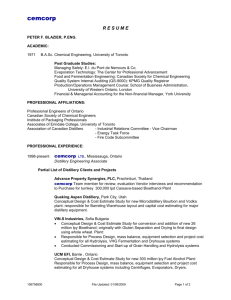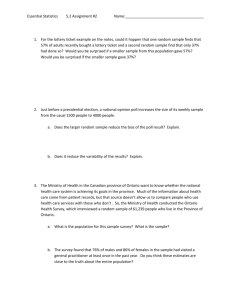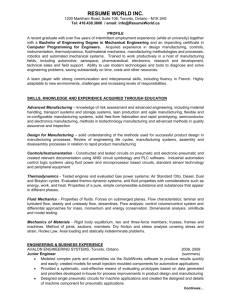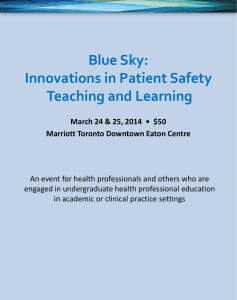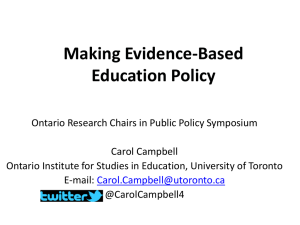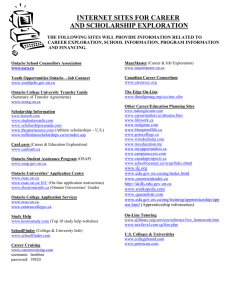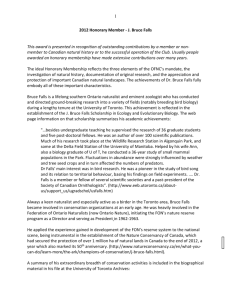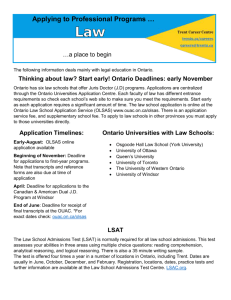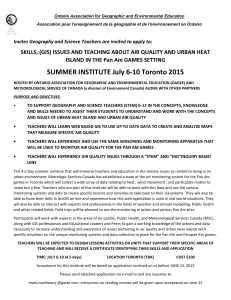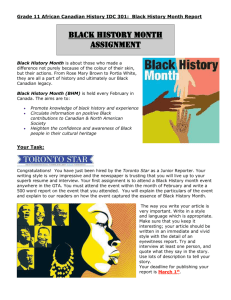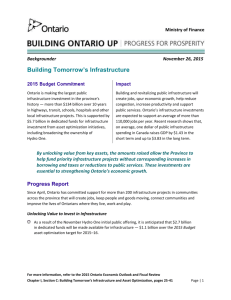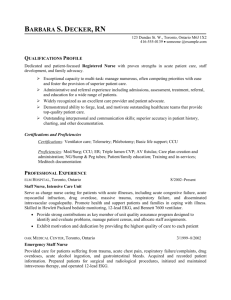here - hwdsb
advertisement
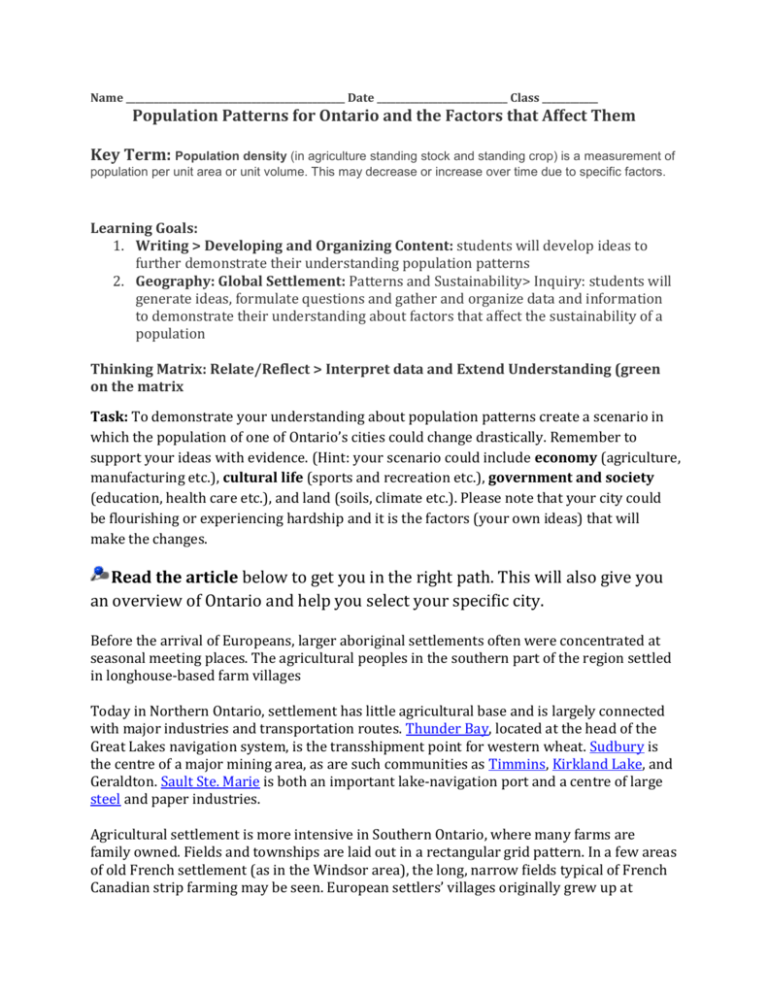
Name _______________________________________________ Date ____________________________ Class ____________ Population Patterns for Ontario and the Factors that Affect Them Key Term: Population density (in agriculture standing stock and standing crop) is a measurement of population per unit area or unit volume. This may decrease or increase over time due to specific factors. Learning Goals: 1. Writing > Developing and Organizing Content: students will develop ideas to further demonstrate their understanding population patterns 2. Geography: Global Settlement: Patterns and Sustainability> Inquiry: students will generate ideas, formulate questions and gather and organize data and information to demonstrate their understanding about factors that affect the sustainability of a population Thinking Matrix: Relate/Reflect > Interpret data and Extend Understanding (green on the matrix Task: To demonstrate your understanding about population patterns create a scenario in which the population of one of Ontario’s cities could change drastically. Remember to support your ideas with evidence. (Hint: your scenario could include economy (agriculture, manufacturing etc.), cultural life (sports and recreation etc.), government and society (education, health care etc.), and land (soils, climate etc.). Please note that your city could be flourishing or experiencing hardship and it is the factors (your own ideas) that will make the changes. Read the article below to get you in the right path. This will also give you an overview of Ontario and help you select your specific city. Before the arrival of Europeans, larger aboriginal settlements often were concentrated at seasonal meeting places. The agricultural peoples in the southern part of the region settled in longhouse-based farm villages Today in Northern Ontario, settlement has little agricultural base and is largely connected with major industries and transportation routes. Thunder Bay, located at the head of the Great Lakes navigation system, is the transshipment point for western wheat. Sudbury is the centre of a major mining area, as are such communities as Timmins, Kirkland Lake, and Geraldton. Sault Ste. Marie is both an important lake-navigation port and a centre of large steel and paper industries. Agricultural settlement is more intensive in Southern Ontario, where many farms are family owned. Fields and townships are laid out in a rectangular grid pattern. In a few areas of old French settlement (as in the Windsor area), the long, narrow fields typical of French Canadian strip farming may be seen. European settlers’ villages originally grew up at water-power sites, at convenient distribution points, and around early garrison centres. Kingston, the first important town, combined those advantages. Major urban growth has been confined almost entirely to the southern parts of the province. The metropolitan complex known as the “Golden Horseshoe” sprawls along the Lake Ontario shore from Oshawa to St. Catharines and includes greater Toronto and the port and industrial city of Hamilton. Toronto is Canada’s largest city. Its hinterland embraces not only much of the province but also a good part of the country. Greater Toronto has a very high rate of growth, which has led to largely uncontrolled suburban sprawl that devours high-grade farmland and threatens the Oak Ridges Moraine. Other important urban concentrations include Windsor, London, Kitchener-Waterloo, Guelph, and Ottawa. Demographic trends Until the 1970s, natural increase contributed more to population growth than immigration. Since the 1980s, though, the falling birth rate has meant that immigration has contributed far more to population growth than has natural increase. The vital statistics (i.e., the birth rate and the death rate) and the rate of population growth for Ontario were roughly the same as the Canadian rates for most of the 20th century. The provincial population more than doubled in the first half of the 20th century and doubled again during the next 35 years. Since then, however, owing to the declining birth rate, growth has slowed, except in the greater Toronto area. Nonetheless, Ontario’s share of the Canadian population has been gradually rising. The province is now overwhelmingly urban, with more than four-fifths of its people living in cities, towns, and suburbs. Ref: http://www.britannica.com/EBchecked/topic/429340/Ontario/272147/Settlementpatterns Lost First, list your your ideas that you will use in your scenario. Secondly, generate questions prior to researching. E.g., what impact will continued urbanization have in this area? What are the costs of the encroachment of human settlement on agricultural or wilderness areas? Lastly, select which form you will use to publish your work (storyboard, written report, article etc.). Categories and Criteria Level and Feedback Knowledge and Understanding Demonstrates knowledge and understanding of the text form and format *The scenario contains a beginning, middle and end. *The details relate to the main idea or event *logical reasoning that supports the proposed point of view *summary of opinion Thinking *Generates ideas that are connected and is able to support ideas with details and reasons (e.g., supports main ideas with relevant information) *Demonstrates critical and creative thinking processes to enhance writing (e.g. understands/writes from a perspective, writes with imagination) Communication *Expresses and organizes ideas in a scenario format with an imagined or projected sequence of events *Communicates for audience (any reader) and purpose (to inform) (e.g. style, voice, tone etc.) *Uses conventions (e.g. grammar, spelling, punctuation) and appropriate vocabulary (e.g. descriptive language of scenes and setting, and linking words and phrases between paragraphs) Application *Transfers knowledge and skills (population patterns/density can change drastically (good or bad) based on specific factors, such as economy, culture Land etc. ) to the writing task *Demonstrates an ability to make connections among topic (how population changes affect people directly), personal experiences and life situations to enhance writing (e.g. Why should we care about cities and how they prosper?)
